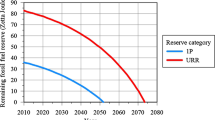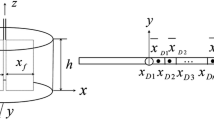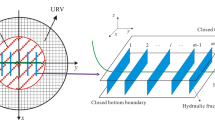Abstract
A new analytical solution of pressure transient analysis is proposed for multistage fracturing horizontal well (MFHW) with finite-conductivity transverse hydraulic fractures in shale gas reservoirs. The effects of absorption, diffusion, viscous flowing, stress sensitivity, flow convergence, skin damage and wellbore storage are simultaneously considered as well in this paper. Laplace transformation, source sink function, perturbation method and superposition principle are, respectively, employed to solve related mathematical models of reservoir system and hydraulic fracture system. And then boundary element method (BEM) is applied to couple reservoir system and hydraulic fracture system. The transient pressure is inverted from Laplace space into real time space with Stehfest numerical inversion algorithm. Based on this new solution, the distribution of transient pseudo-pressure for MFHW with multiple finite-conductivity transverse hydraulic fractures is obtained. Different flowing regimes are identified, and the effects of relevant parameters are analyzed as well. The essence of this paper is considering the effects of transient gas flowing occurrence in finite-conductivity hydraulic fractures with BEM. Compared with some existing models and numerical simulation model of shale gas reservoirs, this proposed new model can provide a relative more accurate analysis of the relevant parameters, especially for the fracture conductivity. In conclusion, this new model provides the relative accurate and comprehensive evaluation results for multistage fracturing horizontal technology.













Similar content being viewed by others
Abbreviations
- Cg:
-
Gas compressibility, MPa−1
- C tf :
-
Total compressibility of natural fractures
- u :
-
Laplace variable
- t :
-
Time, h
- ψ j :
-
Pseudo-pressure, MPa2/cp, j = F, f
- μ :
-
Viscosity, cp
- h :
-
Formation thickness, m
- Lref:
-
Reference length, m
- t D :
-
Dimensionless time
- q D :
-
Dimensionless rate
- Φ f :
-
Porosity of natural fractures, fraction
- x F :
-
Hydraulic fracture half length, m
- x D, y D :
-
Dimensionless space
- q DF :
-
Total dimensionless rate of one fracture
- Sc:
-
Flow-convergence skin
- SF :
-
Fracture damage skin
- k F, k f :
-
Permeability of hydraulic fractures and natural fractures, D
- k fi :
-
Initial permeability of natural fractures, D
- D :
-
Diffusion coefficient, m2/s
- q sc :
-
Well production rate, m3/d
- T :
-
Reservoir temperature, K
- T SC :
-
Standard temperature, K
- P SC :
-
Standard pressure, MPa
- P L :
-
Langmuir pressure, MPa
- V L :
-
Langmuir volume, sm3/m3
- M :
-
The numbers of hydraulic fracture
- x, y :
-
Coordination, m
- r :
-
Radial distance, m
- r D :
-
Dimensionless radial distance
- ε:
-
Integration variable
- x′:
-
Integration variable
- x″:
-
Integration variable
- CFD :
-
Dimensionless conductivity
- C:
-
Wellbore storage coefficient
- q Dr :
-
Dimensionless flux density
- D:
-
Dimensionless
- —:
-
Laplace transform
- ,:
-
Derivative
References
Al-Ahmadi HA, Wattenbarger RA (2011) Triple-porosity models: one further step towards capturing fractured reservoirs heterogeneity. Soc Pet Eng. doi:10.2118/149054-MS
Al-Kobaisi M, Ozkan E, Kazemi H (2004) A hybrid numerical-analytical model of finite-conductivity vertical fractures intercepted by a horizontal well. Soc Pet Eng. doi:10.2118/92040-MS
Archer RA (2008) Impact of stress sensitive permeability on production data analysis. Soc Pet Eng. doi:10.2118/114166-MS
Barenblatt GI, Zheltov IP, Kochina IN (1960) Basic concepts in the theory of seepage of homogeneous liquids in fissured rocks [strata][J]. J Appl Math Mech 24(5):1286–1303
Brown M, Ozkan E, Raghavan R, Kazemi H (2011) Practical solutions for pressure-transient responses of fractured horizontal wells in unconventional shale reservoirs. Soc Pet Eng. doi:10.2118/125043-PA
Buhidma IM, Habbtar A, Rahim Z (2013) Practical considerations for pressure transient analysis of multi-stage fractured horizontal wells in tight sands. Soc Pet Eng. doi:10.2118/168096-MS
Chen C-C, Rajagopal R (1997) A multiply-fractured horizontal well in a rectangular drainage region. Soc Pet Eng. doi:10.2118/37072-PA
Clarkson CR (2013) Production data analysis of unconventional gas wells: review of theory and best practices[J]. Int J Coal Geol 109:101–146
De Swaan OA (1976) Analytic solutions for determining naturally fractured reservoir properties by well testing. Soc Pet Eng. doi:10.2118/5346-PA
El-Banbi AH (1998) Analysis of Tight Gas Wells. PhD. Dissertation, Texas
Guo G, Evans RD (1993) Pressure-transient behavior and inflow performance of horizontal wells intersecting discrete fractures. Soc Pet Eng. doi:10.2118/26446-MS
Horne RN, Temeng KO (1995) Relative productivities and pressure transient modeling of horizontal wells with multiple fractures. Soc Pet Eng. doi:10.2118/29891-MS
Javadpour F (2009) Nanopores and apparent permeability of gas flow in mudrocks (shales and siltstone). Pet Soc Can. doi:10.2118/09-08-16-DA
Javadpour F, Fisher D, Unsworth M (2007) Nanoscale gas flow in shale gas sediments. Pet Soc Can. doi:10.2118/07-10-06
Kazemi H (1969) Pressure transient analysis of naturally fractured reservoirs with uniform fracture distribution. Soc Pet Eng. doi:10.2118/2156-A
Kikani J, Horne RN (1992) Pressure-transient analysis of arbitrarily shaped reservoirs with the boundary-element method. Soc Pet Eng. doi:10.2118/18159-PA
Larsen L, Hegre TM (1991) Pressure-transient behavior of horizontal wells with finite-conductivity vertical fractures. SPE 22076
Larsen L, Hegre TM (1994) Pressure transient analysis of multi-fractured horizontal wells. SPE 28389
Mukherjee H, Economies MJ (1991) A parametric comparison of horizontal and vertical well performance. Soc Pet Eng. doi:10.2118/18303-PA
Nashawi IS (2006) Constant-pressure well test analysis of finite-conductivity hydraulically fractured gas wells influenced by non-Darcy flow effects[J]. J Petrol Sci Eng 53(3):225–238
Ozkan E, Brown ML, Raghavan R, Kazemi H (2011) Comparison of fractured-horizontal-well performance in tight sand and shale reservoirs. Soc Pet Eng. doi:10.2118/121290-PA
Pedrosa OA (1986) Pressure transient response in stress-sensitive formations. Soc Pet Eng. doi:10.2118/15115-MS
Riley MF, Brigham WE, Horne RN (1991) Analytic solutions for elliptical finite-conductivity fractures. Soc Pet Eng. doi:10.2118/22656-MS
Samaniego VF, Cinco LH (1980) Production rate decline in pressure-sensitive reservoirs. Pet Soc Can. doi:10.2118/80-03-03
Stalgorova K, Mattar L (2013) Analytical model for unconventional multifractured composite systems. Soc Pet Eng. doi:10.2118/162516-PA
Stehfest H (1970) Algorithm 368: numerical inversion of Laplace transforms [D5][J]. Commun ACM 13(1):47–49
Valko PP, Amini S (2007) The method of distributed volumetric sources for calculating the transient and pseudosteady-state productivity of complex well-fracture configurations. Soc Pet Eng. doi:10.2118/106279-MS
Vincent MC, Pearson CM, Kullman J (1999) Non-darcy and multiphase flow in propped fractures: case studies illustrate the dramatic effect on well productivity. Soc Pet Eng. doi:10.2118/54630-MS
Wang HT (2014) Performance of multiple fractured horizontal wells in shale gas reservoirs with consideration of multiple mechanisms[J]. J Hydrol 510:299–312
Wang H, Zhang L (2009) A boundary element method applied to pressure transient analysis of geometrically complex gas reservoirs. Soc Pet Eng. doi:10.2118/122055-MS
Warren JE, Root PJ (1963) The behavior of naturally fractured reservoirs. Soc Pet Eng. doi:10.2118/426-PA
**ao J, Wei J (1992) Diffusion mechanism of hydrocarbons in zeolites: I. Theory[J]. Chem Eng Sci 47(5):1123–1141
**aodong W, Wan**g LUO, **aochun HOU et al (2014) Pressure transient analysis of multi-stage fractured horizontal wells in boxed reservoirs[J]. Pet Explor Dev 41(1):82–87
Xu B, Haghighi M, Li X et al (2013) Development of new type curves for production analysis in naturally fractured shale gas/tight gas reservoirs[J]. J Petrol Sci Eng 105:107–115
Zhang W, Zeng P (1992) A boundary element method applied to pressure transient analysis of irregularly shaped double-porosity reservoir. Soc Pet Eng
Zhao Y, Zhang L, Wu F (2012) RETRACTED: pressure transient analysis for multi-fractured horizontal well in shale gas reservoirs[J]. J Petrol Sci Eng 90:31–38
Zhao YL, Zhang LH, Wu F et al (2013a) Analysis of horizontal well pressure behaviour in fractured low permeability reservoirs with consideration of the threshold pressure gradient[J]. J Geophys Eng 10(3):035014
Zhao Y, Zhang L, Zhao J et al (2013b) “Triple porosity” modeling of transient well test and rate decline analysis for multi-fractured horizontal well in shale gas reservoirs[J]. J Pet Sci Eng 110:253–262
Acknowledgments
The authors acknowledge a fund from the National Natural Science Foundation (NNSF) of China (No. 2011ZX05015). And this paper is supported by the fund NNSF of China (No. 2011ZX05015). I would also like to thank the editor and reviewers for their laborious and responsible work.
Author information
Authors and Affiliations
Corresponding author
Appendix
Appendix
The one-dimensional linear flow is assumed in the hydraulic fractures, the compressibility of fractures and gas is ignored, and the flow state in hydraulic fractures meets the continuous pseudo-state theory. Thus, the governing equation is presented as:
Based on the gas state equation, the gas density can be presented as follows:
Meanwhile, the gas pseudo-pressure is defined as the following formation:
Submitting Eqs. (A2) and (A3) into Eq. (A1), one can obtain:
In this paper, we assume that the flow rate along the hydraulic fractures is variable. At arbitrary position (x F, y F), the flow rate from formation into hydraulic fractures can be obtained applying the Darcy’s law:
where Δx represents the microelements, and we make an assumption that the flux density is constant in this microelement.
In terms of the inner boundary condition, we assume that the well keeps constant production rate condition. Similarly, the inner boundary condition can be obtained with Darcy’s law:
where q F is the total production rate of the hydraulic fractures, sm3/d.
With the definition of these dimensionless variables in Table 1, the above equations from Eqs. (A4)–(A6) with the formula of dimensionless can be presented as follows:
And the boundary conditions [Eqs. (A5) and (A6)] also can be converted into the dimensionless formation:
The region that contains the hydraulic fractures and its vicinity is supported by proppants. Therefore, the stress sensitivity can be ignored in this region. The dimensionless pseudo-pressure distributed throughout this region in Laplace domain is as follows:
The boundary conditions [Eqs. (A8) and (A9)] also can be converted into the dimensionless formation:
Rights and permissions
About this article
Cite this article
Dai, Y., Ma, X., Jia, A. et al. Pressure transient analysis of multistage fracturing horizontal wells with finite fracture conductivity in shale gas reservoirs. Environ Earth Sci 75, 940 (2016). https://doi.org/10.1007/s12665-016-5703-5
Received:
Accepted:
Published:
DOI: https://doi.org/10.1007/s12665-016-5703-5




